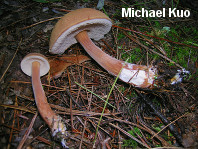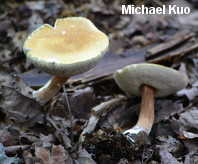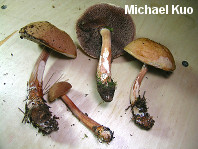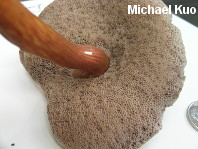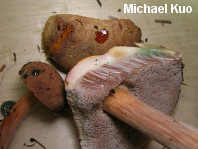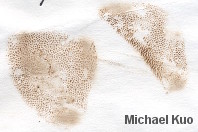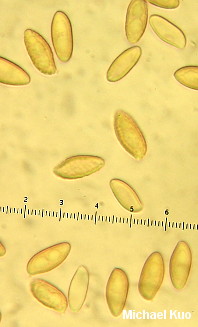| Major Groups > Boletes > Ridged/Pitted-Spored | Tylopilus > Austroboletus gracilis |

|
Austroboletus gracilis [ Basidiomycota > Boletales > Boletaceae > Austroboletus . . . ] by Michael Kuo This beautiful bolete is, as its name suggests, graceful in stature; its stem is typically long and slender. Its pore surface is whitish at first, but becomes pinkish, and eventually pinkish brown, with maturity. It is mycorrhizal with eastern hemlock and other conifers in eastern North America. Under the microscope, Austroboletus gracilis has spores that become very finely pitted with maturity. Previously the species was placed in the genus Tylopilus, and it is called "Tylopilus gracilis" in many field guides. There may be several distinct species hiding out in our current notion of Austroboletus gracilis. It is highly variable in color (ranging from nearly brown to nearly yellow); its stem is sometimes reticulate and sometimes not; and chemical reactions vary fairly widely. Some authors recognize "Austroboletus gracilis var. flavipes," with more yellowish colors, slightly smaller spores, and no reticulation on the stem; and "Austroboletus gracilis var. pulcherripes," with deeper colors and a shorter stem which is coarsely reticulate over the upper two-thirds. Whether or not these varieties correspond to phylogenetic differences remains to be seen. Description: Ecology: Mycorrhizal with eastern hemlock and other conifers; growing alone or scattered; summer and fall; fairly widely distributed in eastern North America, but more common in the north and in the Appalachians. The illustrated and described collections are from Michigan and Pennsylvania. Cap: 3-12 cm; convex, becoming broadly convex; dry; bald or finely velvety; sometimes becoming finely cracked; reddish brown to tawny, tan, or brownish yellow. Pore Surface: Whitish becoming pinkish gray and, eventually, pinkish brown; not bruising; with 1-2 circular to angular pores per mm; tubes to 1 cm deep. Stem: 6-12 cm long; 0.5-1.5 cm thick; gracefully narrowing to apex, or more or less equal; colored like the cap or paler; sometimes slightly curved; frequently longitudinally grooved and/or reticulate; basal mycelium white. Flesh: Whitish, becoming very slowly pinkish when sliced, and sometimes developing chrome yellow stains in the stem base. Odor and Taste: Not distinctive. Chemical Reactions: Ammonia gray--or flashing blue-green, then resolving to purplish gray--on cap surface; negative to pinkish on flesh. KOH orangish brown to red on cap surface; dirty orange on flesh. Iron salts grayish to negative on cap surface; negative to green on flesh. Spore Print: Pinkish brown to brown. Microscopic Features: Spores 14-17 x 5.5-7 µ; widely fusiform; smooth, becoming very minutely pitted when mature; golden in KOH. Hymenial cystidia scattered; fusoid-ventricose to clavate; to about 60 x 12 µ. Pileipellis a collapsing trichoderm, often poorly defined, of hyaline, smooth elements 5-10 µ wide; terminal cells tubular-cylindric, with rounded apices. REFERENCES: (Peck, 1872) Wolfe, 1979. (Saccardo, 1888; Coker & Beers, 1943; Smith & Thiers, 1971, Grund & Harrison, 1976; Smith, Smith & Weber, 1981; Weber & Smith, 1985; Phillips, 1991/2005; Lincoff, 1992; Both, 1993; Barron, 1999; Bessette, Roody & Bessette, 2000; Roody, 2003; McNeil, 2006; Ortiz-Santana et al., 2007; Kuo & Methven, 2014.) Herb. Kuo 09039502, 09080104, 09150715, 09121002, 07211403. This site contains no information about the edibility or toxicity of mushrooms. |
© MushroomExpert.Com |
|
Cite this page as: Kuo, M. (2015, January). Austroboletus gracilis. Retrieved from the MushroomExpert.Com Web site: http://www.mushroomexpert.com/austroboletus_gracilis.html |
